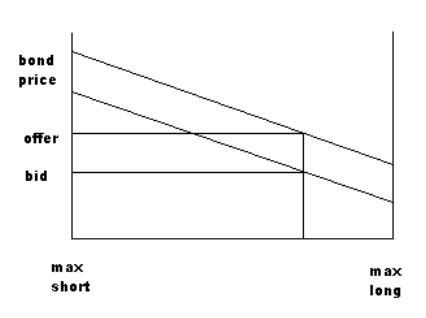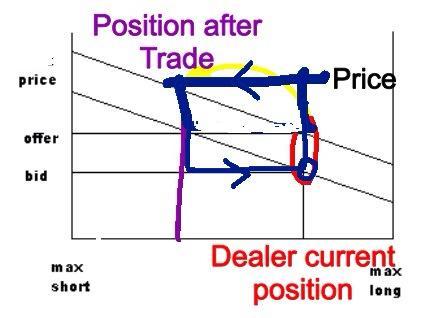The actual exchange rate is decided by the market makers who operate as foreign exchange dealers. A dealer accommodates people who want to change one currency into another, usually for the purpose of trade or investment, dealers charge buyers a higher price than they pay sellers making themselves a profit by providing this service.
To understand what drives FOREX prices we need to understand the foreign exchange dealer function, how do they decide prices and what makes them increase or decrease price.
Jack Treynor in his 1987 article "The Economics of the Dealer Function" provided the definitive view of the way money market dealers operate, he gave us the Treynor model which gives a thorough insight into the motivation and actions of dealers.

The model shown on the left shows the price of a security on the vertical axis and the exposure of the dealer on the horizontal.
Given a set position for the dealer, in the case highlighted the dealer is currently long the security. The mid point on the horizontal axis would be his flat position. The dealers bid and offer prices are shown, the spread being clear as the difference between these two.

Every time a dealer changes his net position his mean price (average of bid and offer) will change. If a customer who wants to buy a substantial amount of the security the dealer has to decide what price to offer the security at. The trade will alter the net position of the dealer, this new position will change the future price of the security, hence it must affect the current price, indeed the dealers current price must reflect what the price is expected to be in the future if it does not people will be able to make profit simply by trading with the dealer and he will consequently loose money.
As an example of this suppose a trader wishes to buy a substantial number of GBP from the dealer to pay for goods bought in the UK from an exporter. If the current dealer position in GBP is shown in red,(according to the diagram he is net long the GBP) after taking the deal, selling GBP to the customer, he will have less GBP, he may be short GBP, his new position is shown in purple.
To ensure the customer cannot make a profit by undoing the deal he must offer the price that would take effect after the deal. Which is higher than the offer price before the deal. The blue box shows what would happen if the customer sold the GBP back immediately, the dealer would make the spread on both trades and the customer would loose money.
As the size of a dealers position grows they take on more and more price risk, they are not in the business of speculation, they are merely providing a service and taking a profit for doing so. If the orders arrive in a symmetrical fashion, equal buy and sell orders, the dealer will be happy his current position will be flat and he will continue to make the spread.
Often an investor will come to the market who has a view on the asset that is not yet reflected in the price, a series of such investors would result in the dealer holding a large position and getting sand bagged along with the other investors who did not have the new insight. Investors decide if their insight is sufficient to cancel the cost of trading, if not they should not trade.
If the dealer reaches his maximum position he will turn to the dealer of last resort, the central bank, to lay off his position.
The balanced dealer
In the above discussion which is a simplified view of the dealer function but sufficient for people to get a good understanding of what happens, the dealer will be constantly exposed to price risk for the underlying security. If that were the case they would be speculative dealers making profit from the movement in currency not from providing a service.The majority of FX dealers do not expose themselves to price risk, they are not speculative dealers. To mitigate the risk the dealer will hedge each position by opening a forward exchange contract. If the value of the security drops it is offset by changes in the forward contract. The price risk has not disappeared it has been transferred to someone else by the forward contract. The forward will often be held by a speculative dealer with a naked long or short position however they may move some of the risk on with more forwards.
The dealer has replaced price risk with liquidity risk as he must now be able to role over the forward contracts as required. Hence the need for liquid markets!
Having discussed the economics of the dealer function which is the main driver of foreign exchange rates we can see that the price that the dealer quotes depends on two distinct things
The volume of buying and selling of a particular currency
The price of the forward contract needed to provide matched book.
1. Estimating the physical demand for a currency
We can get a good estimate of this by looking at two things, the trade balance and the volume of government securities being bought by foreigners. There are other reasons to change currency but these are the two major sources of currency exchange. If a currency has a negative trade balance (importing more than it exports) this will put downward pressure on the exchange rate as people are selling the local currency to buy the currency of the exporting country to pay for goods and services.High yield on government debt will attract foreign buyers who will have to buy the local currency before they purchase the government bond, this effect is very noticeable at the moment with the euro and some of the more peripheral country bonds offering high yield. Figures of foreign ownership of debt are published by each central bank as is their timetable for issuing new
2.Estimating the forward price
We must consider two numbers here, the expected price and the forward price, many people believe these two things should be the same(that is the UIP uncovered interest rate parity). If the two numbers were the same it would be impossible for the speculative dealer to make a profit and the balanced book dealer would not be able to hedge his position. The speculative dealer makes money when the forward price is less than the expected spot price, which is proven empirically to be true.The forward and the expected spot rate are linked closely to interest rate expectations and hence monetary policy.
Having discussed the dealer function in this way and concentrated on the matched book dealer we have a much better understanding of how changes in the prices of FOREX can be explained.
Editors’ Picks

EUR/USD trades around 1.1700 after rebounding from 50-day EMA
EUR/USD gains ground after three days of losses, trading around 1.1700 during the Asian hours on Wednesday. On the daily chart, technical analysis indicates a potential for a bearish bias; the 14-day Relative Strength Index at 47 confirms waning momentum.

GBP/USD climbs above 1.3500 as US Dollar weakens ahead of ISM Services PMI
GBP/USD gains some ground after registering modest gains in the previous session, trading around 1.3510 during the Asian hours on Wednesday. The pair edges higher as the US Dollar struggles ahead of the US ISM Services Purchasing Managers’ Index and JOLTs job openings due later in the day.

Gold pulls back from $4,500 amid profit-taking ahead of key US macro data
Gold struggles to capitalize on its strong weekly gains registered over the past two days and faces rejection near the $4,500 psychological mark, or over a one-week high touched during the Asian session on Wednesday. As investors digest the recent US attack on Venezuela, the prevalent risk-on environment prompts some profit-taking around the commodity.

Bitcoin, Ethereum and Ripple cool off as rally stalls near key resistance zones
Bitcoin, Ethereum, and Ripple prices are taking a breather on Wednesday near their key resistance levels following the recent surge. BTC faces rejection at the $94,253 level, while ETH and XRP follow BTC’s footsteps, struggling near $3,308 and $2.35, respectively.

Implications of US intervention in Venezuela
Events in Venezuela are top of mind for market participants, and while developments are associated with an elevated degree of uncertainty, we are not making any changes to our markets or economic forecasts as a result of the deposition of Nicolás Maduro.
RECOMMENDED LESSONS
Making money in forex is easy if you know how the bankers trade!
I’m often mystified in my educational forex articles why so many traders struggle to make consistent money out of forex trading. The answer has more to do with what they don’t know than what they do know. After working in investment banks for 20 years many of which were as a Chief trader its second knowledge how to extract cash out of the market.
5 Forex News Events You Need To Know
In the fast moving world of currency markets where huge moves can seemingly come from nowhere, it is extremely important for new traders to learn about the various economic indicators and forex news events and releases that shape the markets. Indeed, quickly getting a handle on which data to look out for, what it means, and how to trade it can see new traders quickly become far more profitable and sets up the road to long term success.
Top 10 Chart Patterns Every Trader Should Know
Chart patterns are one of the most effective trading tools for a trader. They are pure price-action, and form on the basis of underlying buying and selling pressure. Chart patterns have a proven track-record, and traders use them to identify continuation or reversal signals, to open positions and identify price targets.
7 Ways to Avoid Forex Scams
The forex industry is recently seeing more and more scams. Here are 7 ways to avoid losing your money in such scams: Forex scams are becoming frequent. Michael Greenberg reports on luxurious expenses, including a submarine bought from the money taken from forex traders. Here’s another report of a forex fraud. So, how can we avoid falling in such forex scams?
What Are the 10 Fatal Mistakes Traders Make
Trading is exciting. Trading is hard. Trading is extremely hard. Some say that it takes more than 10,000 hours to master. Others believe that trading is the way to quick riches. They might be both wrong. What is important to know that no matter how experienced you are, mistakes will be part of the trading process.
The challenge: Timing the market and trader psychology
Successful trading often comes down to timing – entering and exiting trades at the right moments. Yet timing the market is notoriously difficult, largely because human psychology can derail even the best plans. Two powerful emotions in particular – fear and greed – tend to drive trading decisions off course.
